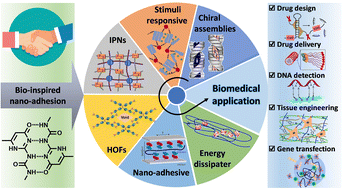Multiple hydrogen bonding driven supramolecular architectures and their biomedical applications
Abstract
Supramolecular chemistry combines the strength of molecular assembly via various molecular interactions. Hydrogen bonding facilitated self-assembly with the advantages of directionality, specificity, reversibility, and strength is a promising approach for constructing advanced supramolecules. There are still some challenges in hydrogen bonding based supramolecular polymers, such as complexity originating from tautomerism of the molecular building modules, the assembly process, and structure versatility of building blocks. In this review, examples are selected to give insights into multiple hydrogen bonding driven emerging supramolecular architectures. We focus on chiral supramolecular assemblies, multiple hydrogen bonding modules as stimuli responsive sources, interpenetrating polymer networks, multiple hydrogen bonding assisted organic frameworks, supramolecular adhesives, energy dissipators, and quantitative analysis of nano-adhesion. The applications in biomedical materials are focused with detailed examples including drug design evolution for myotonic dystrophy, molecular assembly for advanced drug delivery, an indicator displacement strategy for DNA detection, tissue engineering, and self-assembly complexes as gene delivery vectors for gene transfection. In addition, insights into the current challenges and future perspectives of this field to propel the development of multiple hydrogen bonding facilitated supramolecular materials are proposed.

- This article is part of the themed collection: Celebrating the scientific accomplishments of RSC Fellows


 Please wait while we load your content...
Please wait while we load your content...